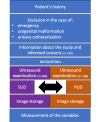Diagnoses of postpartum urinary retention using next-generation non-piezo ultrasound technology: assessing the accuracy and benefits
- PMID: 39738356
- PMCID: PMC11685570
- DOI: 10.1038/s41598-024-83160-6
Diagnoses of postpartum urinary retention using next-generation non-piezo ultrasound technology: assessing the accuracy and benefits
Abstract
Postpartum urinary retention has a wide range of publicized incidences, likely caused by frequent misdiagnosis of this puerperal complication. Especially covert postpartum urinary retention has a high number of missed diagnoses due to the lack of symptoms and the time-extensive diagnostics via ultrasound, leading to no treatment and no appropriate follow-up. To simplify the diagnosis and establish a screening tool we analyzed the application of portable handheld-ultrasound devices (PUD) as used in Point-of-care diagnostics in comparison to established standard ultrasound devices (SUD). This prospective study aimed to evaluate the reliability of non-piezo, chip-based PUD in comparison to the measurement withSUD, containing a piezo transducer, as golden standard for the ultrasound diagnosis of postpartum urinary retention. Randomly, 100 participants between the first and seventh day after delivery in an obstetric ward underwent ultrasound examinations using a EPIQ 5 W (Philips) as SUD and a Butterfly iQ (Butterfly Network) as PUD to compare the accuracy in bladder size after micturition and the estimated post-void residual volume. Intraclass correlation coefficients, Bland-Altman plots, and Pearson correlation coefficients were used for analyzing the reliability and agreement between the measurements of these devices and were calculated for subgroups as body mass index, mode of delivery and timepoint of delivery. The results show a near-perfect agreement (0.994) and correlation (r = 0.982) for estimated post-void residual volume and for most measurements between the two types of ultrasound devices. The agreement rate for the diagnosis of covert postpartum urinary retention is 100%. Subgroup analyses lack a significant difference reflected by agreement and correlation rates. These findings affirm the high reliability of PUD for the diagnosis of postpartum urinary retention and supports their integration into daily clinical practice, thereby simplifying regular controls of the bladder by physicians during daily rounds on the ward. This technology may allow a higher diagnosis rate so that patient care can be optimized and the long-term impact on continence and quality of life can be studied and analysed.
Keywords: Chip-based; Obstetrics; POCUS; Personal-device-based-point-of-care-ultrasound; Piezo-based; Point-of-care-ultrasound; Postpartum; Semiconductors; Urinary retention; Urology.
© 2024. The Author(s).
Conflict of interest statement
Declarations. Competing interests: The authors declare no competing interests.
Figures



Similar articles
-
Next-generation monitoring in obstetrics: Assessing the accuracy of non-piezo portable ultrasound technology.Acta Obstet Gynecol Scand. 2024 Oct;103(10):2031-2041. doi: 10.1111/aogs.14922. Epub 2024 Jul 20. Acta Obstet Gynecol Scand. 2024. PMID: 39032032 Free PMC article.
-
Evaluating the accuracy and reliability of non-piezo portable ultrasound devices in postpartum care.Arch Gynecol Obstet. 2025 Apr;311(4):1039-1049. doi: 10.1007/s00404-024-07744-3. Epub 2024 Oct 4. Arch Gynecol Obstet. 2025. PMID: 39365472 Free PMC article.
-
Medical student training with next-generation handheld ultrasound devices - hands on examination of fetal biometry in obstetrics.BMC Med Educ. 2025 Jan 22;25(1):103. doi: 10.1186/s12909-025-06683-0. BMC Med Educ. 2025. PMID: 39844144 Free PMC article.
-
Postpartum urinary retention: an expert review.Am J Obstet Gynecol. 2023 Jan;228(1):14-21. doi: 10.1016/j.ajog.2022.07.060. Epub 2022 Aug 3. Am J Obstet Gynecol. 2023. PMID: 35932877 Review.
-
Postpartum urinary retention: what are the sequelae? A long-term study and review of the literature.Int Urogynecol J. 2022 Jun;33(6):1601-1608. doi: 10.1007/s00192-021-05074-5. Epub 2022 Feb 7. Int Urogynecol J. 2022. PMID: 35129645 Free PMC article. Review.
Cited by
-
Localization of a contraceptive implant using a silicon chip-based handheld ultrasound device.Arch Gynecol Obstet. 2025 Jun 24. doi: 10.1007/s00404-025-08045-z. Online ahead of print. Arch Gynecol Obstet. 2025. PMID: 40550874
References
-
- Groutz, A. et al. Protracted postpartum urinary retention: The importance of early diagnosis and timely intervention. Neurourol. Urodyn.30, 83–86. 10.1002/nau.20926 (2011). - PubMed
-
- Chai, A. H. L. et al. Prevalence and associated risk factors of retention of urine after caesarean section. Int. Urogynecol. J.19, 537–542. 10.1007/s00192-007-0470-1 (2008). - PubMed
-
- Glavind, K. & Bjork, J. Incidence and treatment of urinary retention postpartum. Int. Urogynecol. J. Pelvic Floor Dysfunct.14, 119–121. 10.1007/s00192-002-1014-3 (2003). - PubMed
-
- Gupta, A. et al. Postpartum urinary retention in women undergoing instrumental delivery: A cross-sectional analytical study. Acta Obstet. Gynecol. Scand.100, 41–47. 10.1111/aogs.13954 (2021). - PubMed
-
- Yip, S., Brieger, G., Hin, L. & Chung, T. Urinary retention in the post-partum period: The relationship between obstetric factors and the post‐partum post‐void residual bladder volume. Acta Obstet. Gynecol. Scand.76, 667–672. 10.3109/00016349709024608 (1997). - PubMed
MeSH terms
LinkOut - more resources
Full Text Sources
Medical

